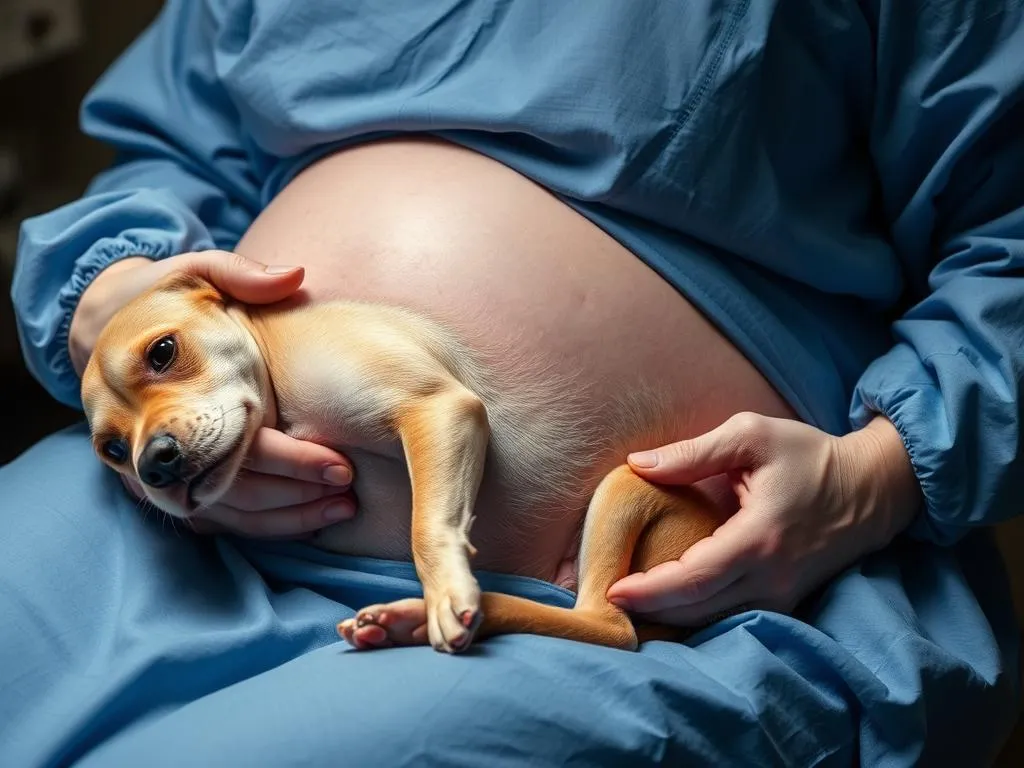
Postpartum eclampsia in dogs is a serious condition that every dog owner should be aware of, particularly those with nursing mothers. Recognizing and treating this condition promptly can mean the difference between life and death for your beloved pet.
Understanding Postpartum Eclampsia
What is Postpartum Eclampsia?
Postpartum eclampsia in dogs, also known as milk fever, is a life-threatening condition that occurs in lactating female dogs. It is characterized by a sudden drop in calcium levels (hypocalcemia) due to the high demand for calcium in milk production. This deficiency can lead to severe neurological symptoms and can escalate quickly if not treated.
The primary cause of postpartum eclampsia is the rapid depletion of calcium during the nursing period. Dogs that have an increased demand for calcium—such as those with large litters—are particularly susceptible. Understanding the difference between eclampsia and other hormonal imbalances, such as hyperparathyroidism or hypoparathyroidism, is crucial for effective diagnosis and treatment.
Symptoms of Postpartum Eclampsia
Recognizing the symptoms of postpartum eclampsia in dogs is essential for timely intervention. Here are the common signs to look for:
-
Behavioral Changes: Nursing dogs may exhibit restlessness, agitation, or anxiety. They could also be overly clingy or unwilling to leave the whelping area.
-
Physical Symptoms: Owners should be vigilant for muscle tremors, seizures, excessive panting, or even collapse. In severe cases, the dog may become unresponsive.
-
Changes in Nursing Behavior: Dogs suffering from this condition may show reluctance to nurse their puppies or may have difficulty doing so.
Risk Factors
Certain factors can increase a dog’s risk of developing postpartum eclampsia:
-
Breed Predisposition: Some breeds, such as toy breeds and those with large litters, are more prone to this condition. Breeds like Yorkshire Terriers, Dachshunds, and Chihuahuas are particularly at risk.
-
Nutrition: Insufficient nutrition during pregnancy can lead to lower calcium reserves. A balanced diet that meets the nutritional needs of pregnant and nursing dogs is critical to prevent this condition.
-
Multiple Births: The more puppies a dog has to nurse, the higher the calcium demand. This makes it essential for owners of dogs with large litters to be aware of the risks.
Diagnosis of Postpartum Eclampsia
Veterinary Examination
If you suspect your dog is suffering from postpartum eclampsia, it is crucial to consult a veterinarian immediately. During the veterinary examination, the vet will assess the dog’s health history, perform a physical examination, and look for specific symptoms related to the condition.
Veterinary diagnostics may include:
-
Blood Tests: A blood test will help determine the calcium levels in the dog’s bloodstream, confirming hypocalcemia.
-
Physical Assessments: The vet will check for neurological symptoms and other signs indicative of a health crisis.
Differentiating From Other Conditions
It’s important to differentiate postpartum eclampsia in dogs from other conditions that may present similar symptoms, such as:
-
Seizure Disorders: Conditions like epilepsy can mimic the neurological signs of eclampsia.
-
Hypoglycemia: Low blood sugar can lead to tremors and seizures, so it’s vital to rule this out through testing.
-
Toxins or Infections: Certain toxins or infections can cause similar symptoms, making accurate diagnosis critical for effective treatment.
Treatment Options
Immediate Care
If you suspect your dog is experiencing postpartum eclampsia, immediate action is required. Here are some first aid steps to take before reaching the veterinarian:
-
Stay Calm: Your dog can sense your anxiety, which may increase her stress.
-
Keep Her Comfortable: Provide a quiet, warm area free from distractions. Limit movement to prevent injury.
-
Do Not Feed: Avoid giving your dog food or water until you consult with the veterinarian, as this can complicate the situation.
Veterinary Treatment
Once at the veterinary clinic, the treatment for postpartum eclampsia often involves:
-
Calcium Supplements: The primary treatment is the administration of calcium gluconate, either intravenously or subcutaneously, depending on the severity of the condition.
-
Monitoring: After treatment, dogs may need to be monitored closely for any recurrence of symptoms. Follow-up exams and blood tests may be needed to ensure calcium levels return to normal.
-
Duration of Treatment: The duration of treatment can vary based on the severity of the condition and how quickly the dog responds to therapy.
Home Care and Management
After your dog receives treatment for postpartum eclampsia, home care is essential for her recovery:
-
Dietary Recommendations: Provide a high-quality, balanced diet that includes adequate calcium and other essential nutrients. Consult your veterinarian for specific dietary recommendations tailored to your dog’s needs.
-
Supplements: Your vet might suggest calcium and vitamin D supplements to help maintain proper calcium levels during lactation.
-
Stress-Free Environment: Ensure your dog has a calm and quiet space where she can nurse her puppies without disturbances, as stress can exacerbate health issues.
Preventative Measures
Nutritional Guidance
Preventing postpartum eclampsia in dogs begins with proper nutrition:
-
Diet for Pregnant and Nursing Dogs: A high-quality diet rich in protein, calcium, and other vital nutrients is essential during pregnancy and nursing. Look for foods formulated specifically for pregnant or nursing dogs.
-
Calcium and Other Minerals: Calcium is crucial, but balance is key. Over-supplementation can also lead to health problems, so always consult your veterinarian for recommendations.
Regular Veterinary Check-ups
Routine veterinary visits during pregnancy and lactation are vital for the health of both the mother and her puppies:
-
Health Assessments: Regular check-ups can help detect nutritional deficiencies and other potential health issues before they escalate.
-
Vaccinations and Preventive Care: Keeping your dog up-to-date on vaccinations and preventive treatments can help reduce the risk of infections that could complicate her health during this critical time.
Awareness and Education
Knowledge is power when it comes to preventing postpartum eclampsia:
-
Educating Dog Owners: Understanding the signs, symptoms, and risk factors associated with this condition can help owners act quickly in emergencies.
-
Resources for Ongoing Education: Utilize veterinary clinics and reputable pet health websites to stay informed about canine health issues.
Frequently Asked Questions (FAQs)
Can postpartum eclampsia occur in non-pregnant dogs?
No, postpartum eclampsia in dogs specifically relates to lactating females. However, non-pregnant dogs can experience hypocalcemia due to other health issues.
What happens if postpartum eclampsia is left untreated?
If left untreated, postpartum eclampsia can lead to severe complications, including seizures, coma, and even death due to hypocalcemia.
How can I support my dog during recovery?
Support your dog by providing a quiet environment, adhering to dietary recommendations, ensuring she stays hydrated, and following up with veterinary care as needed.
Are there long-term effects of postpartum eclampsia?
Most dogs recover fully from postpartum eclampsia, but some may experience recurrent episodes in future pregnancies. Ongoing veterinary care and proper nutrition can help mitigate these risks.
Conclusion
Recognizing and treating postpartum eclampsia in dogs is vital for the health of both the mother and her puppies. By understanding the symptoms, risk factors, and treatment options, dog owners can ensure timely intervention and support for their pets. Maintaining a focus on overall dog health through proper nutrition and regular veterinary care will contribute to a happy, healthy life for your furry family members.









